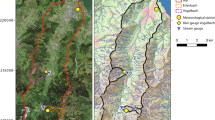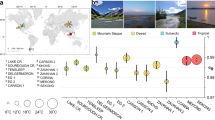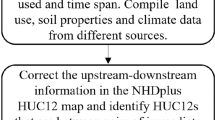Abstract
Adapting to climate and land-use changes requires accurate prediction of river flow dynamics, particularly the seasonally varying water fraction with a rapid response to hydroclimate changes. By analysing stable isotopes in water molecules from precipitation and rivers, here we identified the young water fraction (<2–3 months) and introduced a dynamic water retention indicator to depict river flow dynamics. Examining 20,045 samples from 136 perennial rivers and 45 large catchments globally, we categorized dynamic water retention as high, moderate or low. Around 25% of rivers showed low dynamic water retention, indicating faster responses to hydroclimate events, whereas 50% exhibited high dynamic water retention, suggesting slower responses. Dynamic water retention and young water fraction correlated with changes in crop cover, forest cover, air temperature and precipitation, demonstrating temporal variations in three European rivers with decade-long isotope records. Isotope monitoring of rivers emerges as a cost-effective tool for understanding river flow dynamics and improving water resource management within ongoing hydroclimate and land-use changes.
This is a preview of subscription content, access via your institution
Access options
Subscribe to this journal
Receive 12 digital issues and online access to articles
$99.00 per year
only $8.25 per issue
Buy this article
- Purchase on Springer Link
- Instant access to full article PDF
Prices may be subject to local taxes which are calculated during checkout




Similar content being viewed by others
Data availability
The authors declare that the data supporting the findings of this study are available within the paper and its Supplementary Information files. The isotope records for the different rivers are available open access at the GNIR (https://www.iaea.org/services/networks/gnir). The isotope records in precipitation are available open access at the GNIP (https://www.iaea.org/services/networks/gnip). The database for the Random Forest analysis is included in the Supplementary Information. Source data are provided with this paper.
Code availability
The R code for the Random Forest model is included in the Supplementary Information.
References
State of Global Water Resources (WMO, 2022); https://public.wmo.int/en/our-mandate/water/state-of-global-water-resources-2022
The OECD Environmental Outlook to 2050 (OECD & PBL Netherlands Environmental Assessment Agency, 2012); https://www.oecd.org/env/indicators-modelling-outlooks/49846090.pdf
Mekonnen, M. M. & Hoekstra, A. Y. Four billion people facing severe water scarcity. Sci. Adv. 2, e1500323 (2016).
Vanham, D. et al. Physical water scarcity metrics for monitoring progress towards SDG target 6.4: an evaluation of indicator 6.4. 2 ‘level of water stress’. Sci. Total Environ. 613, 218–232 (2018).
IPCC in Climate Change 2023: Synthesis Report (eds Core Writing Team et al.) 35–115 (IPCC, 2023).
Vystavna, Y., Harjung, A., Monteiro, L., Matiatos, I. & Wassenaar, L. I. Stable isotopes in global lakes integrate catchment and climatic controls on evaporation. Nat. Commun. 17, 7224 (2021).
Gleeson, T. et al. The global volume and distribution of modern groundwater. Nat. Geosci. 9, 161–167 (2016).
Luo, K. et al. Attribution of hydrological change in Heihe River Basin to climate and land use change in the past three decades. Sci. Rep. 6, 33704 (2016).
Basheer, M. et al. Cooperative adaptive management of the Nile River with climate and socio-economic uncertainties. Nat. Clim. Change 13, 48–57 (2023).
Benettin, P. et al. Transit time estimation in catchments: recent developments and future directions. Water Resour. Res. 58, e2022WR033096 (2022).
McGuire, K. J. & McDonnell, J. J. A review and evaluation of catchment transit time modelling. J. Hydrol. 330, 543–563 (2006).
Jasechko, S., Kirchner, J., Welker, J. & McDonell, J. J. Substantial proportion of global streamflow less than three months old. Nat. Geosci. 9, 126–129 (2016).
Soulsby, C. & Tetzlaff, D. Towards simple approaches for mean residence time estimation in ungauged basins using tracers and soil distributions. J. Hydrol. 363, 60–74 (2008).
McGuire, K. J. et al. The role of topography on catchment-scale water residence time. Water Resour. Res. 41, W05002 (2005).
Ferguson, G. et al. Groundwater deeper than 500 m contributes less than 0.1% of global river discharge. Commun. Earth Environ. 4, 48 (2023).
Hermann, A. & Stichler, A. Runoff modeling using environmental isotopes. In Proc. IUFRO Workshop on Water and Nutrient Simulation Models, Birmensdorf (ed. Bosshard, W.) 41–58 (Birmensdorf : Swiss Federal Institute of Forestry Research, 1981).
Kirchner, J. W. Aggregation in environmental systems–part 1: seasonal tracer cycles quantify young water fractions, but not mean transit times, in spatially heterogeneous catchments. Hydrol. Earth Syst. Sci. 20, 279–297 (2016).
von Freyberg, J., Allen, S. T., Seeger, S., Weiler, M. & Kirchner, J. W. Sensitivity of young water fractions to hydro-climatic forcing and landscape properties across 22 Swiss catchments. Hydrol. Earth Syst. Sci. 22, 3841–3861 (2018).
Lyon, S. W. et al. Controls on snowmelt water mean transit times in northern boreal catchments. Hydrol. Process. 24, 1672–1684 (2010).
Jung, Y.-Y. et al. Mean transit time and subsurface flow paths in a humid temperate headwater catchment with granitic bedrock. J. Hydrol. 587, 124942 (2020).
Cartwright, I. et al. The variation and controls of mean transit times in Australian headwater catchments. Hydrol. Process. 34, 4034–4048 (2020).
Barua, S. et al. Sources and mean transit times of intermittent streamflow in semi-arid headwater catchments. J. Hydrol. 604, 127208 (2022).
Rozanski, K., Araguas-Araguas, L. & Gonfiantini, R. Relation between long-term trends of oxygen-18 isotope composition of precipitation and climate. Science 258, 981–985 (1992).
Vystavna, Y., Matiatos, I. & Wassenaar, L. I. Temperature and precipitation effects on the isotopic composition of global precipitation reveal long-term climate dynamics. Sci. Rep. 11, 18503 (2021).
Halder, J., Terzer, S., Wassenaar, L. I., Araguás-Araguás, L. J. & Aggarwal, P. K. The Global Network of Isotopes in Rivers (GNIR): integration of water isotopes in watershed observation and riverine research. Hydrol. Earth Syst. Sci. 19, 3419–3431 (2015).
Liaw, A. & Wiener, M. Classification and regression by randomForest. R News 2, 18–22 (2002).
Andréassian, V. Waters and forests: from historical controversy to scientific debate. J. Hydrol. 291, 1–27 (2004).
Zhang, M. & Wei, X. Deforestation, forestation, and water supply. Science 371, 990–991 (2021).
Li, H. et al. Tracing snowmelt paths in an integrated hydrological model for understanding seasonal snowmelt contribution at basin scale. J. Geophys. Res. Atmos. 124, 8871–9770 (2019).
Smith, T. & Bookhagen, B. Changes in seasonal snow water equivalent distribution in high mountain Asia (1987 to 2009). Sci. Adv. 4, e1701550 (2018).
Dimitrova-Petrova, K., Geris, J., Wilkinson, M. E., Lilly, A. & Soulsby, C. Using isotopes to understand the evolution of water ages in disturbed mixed land-use catchments. Hydrol. Process. 34, 972–990 (2020).
Stein, L. M., Clark, P., Knoben, W. J. M., Pianosi, F. & Woods, R. A. How do climate and catchment attributes influence flood generating processes? A large-sample study for 671 catchments across the contiguous USA. Water Resour. Res. 57, e2020WR028300 (2021).
Huss, M. Present and future contribution of glacier storage change to runoff from macroscale drainage basins in Europe. Water Resour. Res. 47, W07511 (2011).
Castellazzi, P. et al. Glacial melt and potential impacts on water resources in the Canadian Rocky Mountains. Water Resour. Res. 55, 10191–10217 (2019).
Bebi, P. et al. Changes of forest cover and disturbance regimes in the mountain forests of the Alps. Ecol. Manage. 388, 43–56 (2016).
Hrkal, Z., Milický, M. & Tesař, M. Climate change in Central Europe and the sensitivity of the hard rock aquifer in the Bohemian Massif to decline of recharge: case study from the Bohemian Massif. Environ. Earth. Sci. 59, 703–713 (2009).
Eppes, B. et al. Warmer, wetter climates accelerate mechanical weathering in field data, independent of stress-loading. Geophys. Res. Lett. 47, GLO89062 (2020).
Matiu, M. et al. Observed snow depth trends in the European Alps: 1971 to 2019. Cryosphere 15, 1343–1382 (2021).
Potopová, V., Boroneanţ, C., Možný, M. & Soukup, J. Driving role of snow cover on soil moisture and drought development during the growing season in the Czech Republic. Int. J. Climatol. 36, 3741–3758 (2016).
Hanus, S. et al. Future changes in annual, seasonal and monthly runoff signatures in contrasting Alpine catchments in Austria. Hydrol. Earth Syst. Sci. 25, 3429–3453 (2021).
Kilianová, H., Pechanec, V., Brus, J., Kirchner, K. & Machar, I. Analysis of the development of land use in the Morava River floodplain, with special emphasis on the landscape matrix. Moravian Geogr. Rep. 25, 46–59 (2017).
Oki, T. & Kanae, S. Global hydrological cycles and world water resources. Science 313, 1068–1072 (2006).
Nelson, D. B., Basler, D. & Kahmen, A. Precipitation isotope time series predictions from machine learning applied in Europe. Proc. Nat. Acad. Sci. USA 118, e2024107118 (2021).
Reynolds, D. in Encyclopedia of Biometrics (eds Li, S. Z. & Jain, A.) 659–663 (Springer, 2009); https://doi.org/10.1007/978-0-387-73003-5_196
Paluszynska, A., Biecek, P. & Jiang, Y. randomForestExplainer: Explaining and Visulizing Random Forests in Terms of Variable Importance. R version 0.10.1 https://cran.r-project.org/web/packages/randomForestExplainer/randomForestExplainer.pdf (2022).
Global Data Runoff Center: Major River Basins of the World / Global Runoff Data Centre, GRDC 2nd rev. ext. edn (Federal Institute of Hydrology, 2021).
Mann, H. B. Nonparametric tests against trend. Econometrica 13, 245–259 (1945).
Kendall, M. G. Rank Correlation Methods (Griffin, 1955).
Acknowledgements
The authors received no specific funding for this work.
Author information
Authors and Affiliations
Contributions
Y.V. designed the study, developed and ran the machine learning model simulations, did the analysis and wrote the paper. L.C. did the statistical analysis and prepared the databases. A.H. provided support on the data collection and R scripts development, reviewed the machine learning model and output analysis and helped in writing and revision of the paper. D.X.S. assisted in the precipitation and run-off isotope data modelling and validation and helped in writing and revision of the paper. A.W. assisted in the data analysis and interpretation, developed figures and reviewed the paper. J.M. advised on hypotheses, hydroclimate assessment and paper writing. J.C. coordinated the study design and reviewed figures and the paper.
Corresponding author
Ethics declarations
Competing interests
The authors declare no competing interests.
Peer review
Peer review information
Nature Water thanks the anonymous reviewers for their contribution to the peer review of this work.
Additional information
Publisher’s note Springer Nature remains neutral with regard to jurisdictional claims in published maps and institutional affiliations.
Supplementary information
Supplementary Information
Supplementary Figs. 1–3 and Table 1.
Supplementary Code 1
The R code for the Random Forest model.
Source data
Source Data Fig. 2
Source data for the Random Forest model.
Source Data Fig. 3
Source data for the Random Forest model.
Rights and permissions
Springer Nature or its licensor (e.g. a society or other partner) holds exclusive rights to this article under a publishing agreement with the author(s) or other rightsholder(s); author self-archiving of the accepted manuscript version of this article is solely governed by the terms of such publishing agreement and applicable law.
About this article
Cite this article
Vystavna, Y., Chavanne, L., Harjung, A. et al. Predicting river flow dynamics using stable isotopes for better adaptation to climate and land-use changes. Nat Water (2024). https://doi.org/10.1038/s44221-024-00280-z
Received:
Accepted:
Published:
DOI: https://doi.org/10.1038/s44221-024-00280-z



